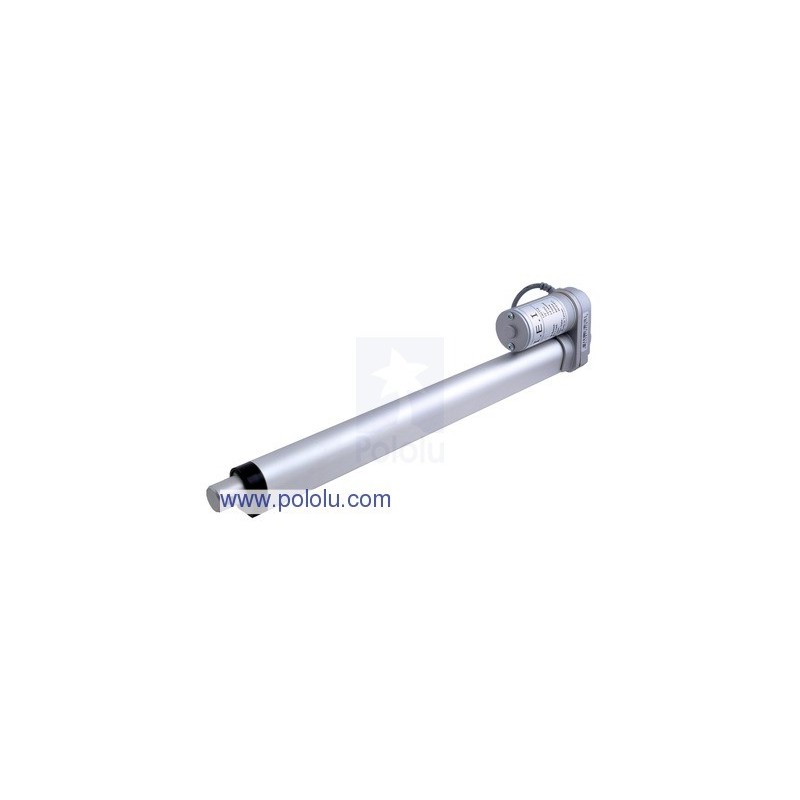



zł755.23 tax excl.
Linear actuator LACT12-12V-20 with a 30.5 cm stroke and a 20:1 gear ratio reaches a force of 500 N and a speed of 12.3 mm/s. The model without feedback is intended for applications where reliability and control of end stroke positions are important.
Linear actuator with a nominal supply voltage of 12 V, equipped with a 20:1 reduction gear which provides the actuator with a dynamic load of 500 N and a maximum speed of 1.23 cm/s, and also withstands a static load of up to 2500 N. Limit switches at each end make it easy to control the actuator throughout the entire range of motion, and the worm drive ensures that the shaft will hold its position even without power. Version with a 30.5 cm stroke, without feedback.
Manufacturer BTC Korporacja sp. z o. o. Lwowska 5 05-120 Legionowo Poland sprzedaz@kamami.pl 22 767 36 20
Responsible person BTC Korporacja sp. z o. o. Lwowska 5 05-120 Legionowo Poland sprzedaz@kamami.pl 22 767 36 20
Linear actuator LACT6P-12V-20 with a 15.2 cm stroke and a 20:1 gear ratio provides a force of 500 N and the ability to monitor position thanks to the built-in potentiometer. Limit switches and a worm drive ensure precise and stable operation in motion control systems.
Linear actuator LACT12P-12V-20 with feedback, 30 cm stroke, nominal supply voltage 12 V, and extension speed 15 mm/s. Pololu 2313
No product available!
A miniature linear actuator that has a stroke range of up to 50 mm at a speed of 3 to 5 mm/s. It has a built-in motor and is powered by a voltage of 3 to 6 V
No product available!
42" Extension Cable for Concentric LD Linear Actuators
Linear actuator LACT4P-12V-20 with a 10.2 cm stroke and a 20:1 gear ratio offers a force of 500 N and a feedback signal from the potentiometer for precise position monitoring. The design with limit switches and a worm drive works well in systems requiring accurate motion control.
No product available!
Linear actuator LACT10-12V-20 with a 25.4 cm stroke and a 20:1 gear ratio offers a force of 500 N and position stability without the need for power. A solution without feedback, suitable for applications in automation systems and linear mechanisms.
No product available!
No product available!
Linear actuator LACT2-12V-20 with 5 cm stroke and 20:1 gearbox offers 500 N force and speed up to 12.3 mm/s. Model with limit switches and worm drive, designed for applications requiring precise operation without the need for feedback.
No product available!
Linear actuator LACT10P-12V-20 with 25.4 cm stroke and 20:1 gearbox generates 500 N force and provides feedback through a built-in potentiometer. Limit switches and worm drive ensure full control and motion stability in automation and robotics applications.
No product available!
DC-AC converter, also referred to as an inverter. It converts a constant voltage (DC) of 12 V to an alternating voltage (AC) of 220 V, 380 V or 18 V
Linear actuator LACT4-12V-20 with a 10.2 cm stroke and a 20:1 gear ratio reaches a force of 500 N and a speed of 12.3 mm/s. The design with a worm drive and limit switches is intended for applications requiring stable operation without feedback.
No product available!
No product available!
A medium-duty linear cylinder, it can lift loads up to 100 kgf (1000 N) and withstand a static load of up to 450 kgf (4500 N), the nominal extension of the actuator is 25 cm. The power supply voltage is 12 V. This version of the actuator has a built-in potentiometer for reading the position of the actuator or, for example, feedback implementations. Pololu 3618
No product available!
Mounting Bracket for Concentric LD Linear Actuators
No product available!
Linear solenoid with a nominal operating voltage of 5 V. It allows you to create a linear motion to move elements or control switches and levers. JF-0530B
Linear actuator LACT4P-12V-5 with 10.2 cm stroke and 5:1 gearbox reaches a speed of 43 mm/s with a force up to 90 N. The built-in potentiometer enables position monitoring in projects requiring precise linear motion control.
No product available!

Linear actuator LACT12-12V-20 with a 30.5 cm stroke and a 20:1 gear ratio reaches a force of 500 N and a speed of 12.3 mm/s. The model without feedback is intended for applications where reliability and control of end stroke positions are important.
